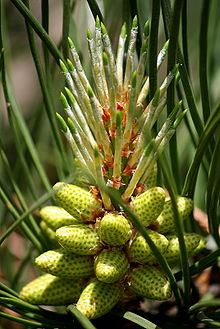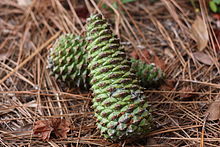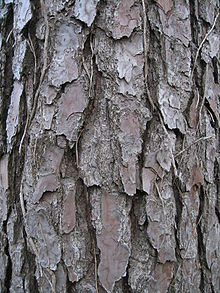- Pinus taeda
-
Pinus taeda Characteristic appearance of loblolly pines, south Mississippi,USA Conservation status Scientific classification Kingdom: Plantae Class: Pinopsida Order: Pinales Family: Pinaceae Genus: Pinus Subgenus: Pinus Species: P. taeda Binomial name Pinus taeda
L.
Natural range of loblolly pine Pinus taeda (Loblolly Pine) is one of several pines native to the Southeastern United States, from central Texas east to Florida, and north to Delaware.[2] It is particularly dominant in the eastern half of North Carolina, where there are huge expanses consisting solely of Loblolly Pine trees. In the rest of the South, forests often contain Loblolly Pines along with many other species of trees. The wood industry classifies the species as a southern yellow pine.
Contents
Description
The trees reach a height of 30–35 m (98–115 ft) with a diameter of 0.4–1.5 m (1.3–4.9 ft). Exceptional specimens may reach 50 m (160 ft) tall, the largest of the southern pines. Its needles are in bundles of three, sometimes twisted, and measure 12–22 cm (4.7–8.7 in) long; an intermediate length for southern pines, shorter than those of the Longleaf Pine or Slash Pine, but longer than those of the Shortleaf Pine and Spruce Pine. The needles usually last up to two years before they fall, which gives the species its evergreen character. Although some needles fall throughout the year due to severe weather, insect damage, and drought, most needles fall during the autumn and winter of their second year. The seed cones are green, ripening pale buff-brown, 7–13 cm (2.8–5.1 in) in length, 2–3 cm (0.79–1.2 in) broad when closed, opening to 4–6 cm (1.6–2.4 in) wide, each scale bearing a sharp 3–6 mm spine.[2][3]
The tallest Loblolly Pine currently known, in Congaree National Park, is 51.4 m (169 ft) tall, and the largest, also in Congaree National Park, is 42 cubic meters in volume.[4]
Name
The word loblolly means "low, wet place",[5] but these trees are not limited to that specific habitat. Loblolly Pines grow well in acidic clay soil, which is common throughout the South, and are thus often found in large stands in rural places. Other old names, now rarely used, include oldfield pine, due to its status as an early colonizer of abandoned fields; bull pine, due to its size (several other yellow pines are also often so named, especially large isolated specimens); rosemary pine, due to loblolly's distinctive fragrance compared to the other southern pines; and North Carolina pine.[6] For the scientific name, Pinus is the Latin name for the pines and taeda refers to the resinous wood.[7]
Ecology
With the advent of wildfire suppression, Loblolly Pine has come to prevalence in some parts of the Deep South that were once populated with greater numbers of Longleaf Pine and, especially in northern Florida, Slash Pine.[8]
The rate of growth is rapid, even among the generally fast-growing southern pines. The yellowish, resinous wood is highly prized for lumber, but is also used for wood pulp. This tree is commercially grown in extensive plantations, along with Slash Pine.[9]
Loblolly Pine is the pine of the Lost Pines Forest around Bastrop, Texas, and in McKinney Roughs along the Texas Colorado River. These are isolated populations on areas of acidic sandy soil, surrounded by alkaline clays that are poor for pine growth.
A study using Loblolly Pines showed that higher atmospheric carbon dioxide levels may help the trees to endure ice storms better.[10]
Notable trees
The famous "Eisenhower Tree" on the 17th hole of Augusta National Golf Club is a Loblolly Pine. U.S. President Dwight D. Eisenhower, an Augusta National member, hit the tree so many times that, at a 1956 club meeting, he proposed that it be cut down. Not wanting to offend the President, the club's chairman, Clifford Roberts, immediately adjourned the meeting rather than reject the request outright.
The University of Arkansas at Fort Smith is home to the "City Champion," winner of the City of Fort Smith TreeQuest 2004. This beautiful Loblolly Pine is located in a row of trees set to be demolished to make way for an expansion to the campus library. The two rows of loblolly pines were originally planted by Dr. Hattie May Butterfield in the 1950s as a symbolic wall to separate the vocational programs and the liberal arts faculty, between whom there was a rift.
References
- ^ Conifer Specialist Group (1998). Pinus taeda. 2006. IUCN Red List of Threatened Species. IUCN 2006. www.iucnredlist.org. Retrieved on 12 May 2006.
- ^ a b Flora of North America: Pinus taeda
- ^ Farjon, A. (2005). Pines. Drawings and descriptions of the genus Pinus, ed.2. Brill, Leiden ISBN 90 04 13916 8.
- ^ Gymnosperm Database: Pinus taeda
- ^ The American Heritage Dictionary of the English Language: Loblolly.
- ^ Moore, Gerry; Kershner, Bruce; Craig Tufts; Daniel Mathews; Gil Nelson; Spellenberg, Richard; Thieret, John W.; Terry Purinton; Block, Andrew (2008). National Wildlife Federation Field Guide to Trees of North America. New York: Sterling. p. 73. ISBN 1-4027-3875-7.
- ^ Oklahoma Biological Survey: Pinus taeda L.
- ^ Richardson, D. M., & Rundel, P. W. (1998). Ecology and biogeography of Pinus: an introduction. Pages 3–46 in Richardson, D. M., ed. Ecology and biogeography of Pinus. Cambridge University Press ISBN 0521551765.
- ^ USDA FS: Silvics of Trees of North America: Pinus taeda
- ^ Greenhouse Gas Good for Some Trees - LiveScience.com
Categories:- IUCN Red List least concern species
- Pinus
- Trees of the Southeastern United States
- Trees of Eastern Texas
- Trees of Alabama
- Trees of humid continental climate
- Trees of North Carolina
- Least concern plants
- Symbols of Arkansas
Wikimedia Foundation. 2010.





